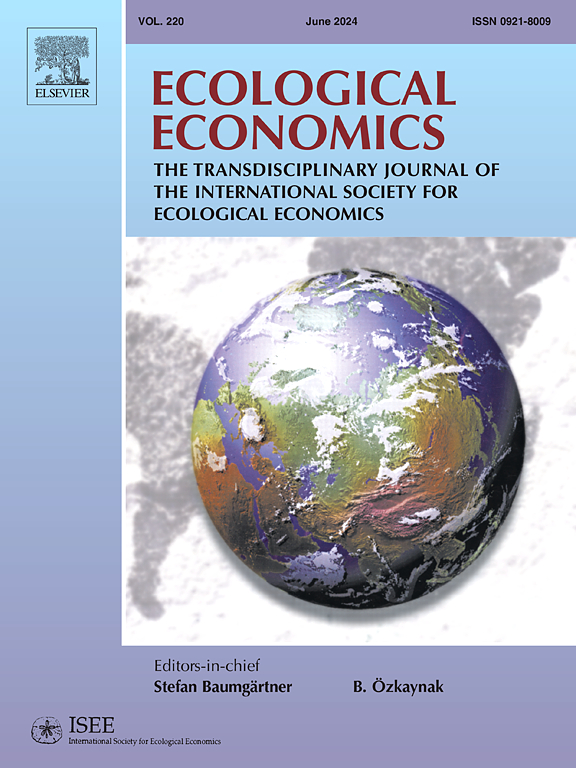人口、富裕程度和城市化对当地空气污染和土地变化的影响--对德国各地区的 STIRPAT 分析
IF 6.6
2区 经济学
Q1 ECOLOGY
引用次数: 0
摘要
人为环境影响严重威胁着城市和县城的可持续发展。本文采用 STIRPAT 方法,对人口、经济增长和技术变革在当地空气污染和土壤密封演变中所起的作用进行了原创性评估。分析涵盖 1990 年至 2020 年期间德国 367 个县和自治市(NUTS 3 级别)的发展情况。结果表明,所有县的氮氧化物排放和土壤封闭的发展都与汽车保有量、房屋数量和地区人口数量明显相关。与此相反,与人均国内生产总值、工业制造业比重和城市密度相关的环境影响则取决于地区类型。最后,在人口和人均 GDP 对氮氧化物排放的影响方面,结果显示出非线性(EKC)动态。环境政策需要关注居住结构和相关变量的水平。本文章由计算机程序翻译,如有差异,请以英文原文为准。
Impacts of population, affluence and urbanization on local air pollution and land transformation – A regional STIRPAT analysis for German districts
Anthropogenic environmental impacts substantially threaten the sustainable development of cities and counties. This paper offers an original assessment of the role played by population, economic growth and technology change in the evolution of local air pollution and soil sealing, using the STIRPAT approach. The analysis covers the development of 367 German counties and autonomous cities (NUTS 3 level) between 1990 and 2020. Results indicate that the development of NOx emissions and soil sealing is clearly related to car ownership, number of houses and regional population for all counties. In contrast to, environmental impacts related to GDP per capita, share of industrial manufacturing and urban density depend on the types of regions. Finally, results show non-linear (EKC) dynamics regarding the impacts of population and GDP per capita on NOx emissions. Environmental policies need to take care about the settlement structures and the level of relevant variables.
求助全文
通过发布文献求助,成功后即可免费获取论文全文。
去求助
来源期刊

Ecological Economics
环境科学-环境科学
CiteScore
12.00
自引率
5.70%
发文量
313
审稿时长
6 months
期刊介绍:
Ecological Economics is concerned with extending and integrating the understanding of the interfaces and interplay between "nature''s household" (ecosystems) and "humanity''s household" (the economy). Ecological economics is an interdisciplinary field defined by a set of concrete problems or challenges related to governing economic activity in a way that promotes human well-being, sustainability, and justice. The journal thus emphasizes critical work that draws on and integrates elements of ecological science, economics, and the analysis of values, behaviors, cultural practices, institutional structures, and societal dynamics. The journal is transdisciplinary in spirit and methodologically open, drawing on the insights offered by a variety of intellectual traditions, and appealing to a diverse readership.
Specific research areas covered include: valuation of natural resources, sustainable agriculture and development, ecologically integrated technology, integrated ecologic-economic modelling at scales from local to regional to global, implications of thermodynamics for economics and ecology, renewable resource management and conservation, critical assessments of the basic assumptions underlying current economic and ecological paradigms and the implications of alternative assumptions, economic and ecological consequences of genetically engineered organisms, and gene pool inventory and management, alternative principles for valuing natural wealth, integrating natural resources and environmental services into national income and wealth accounts, methods of implementing efficient environmental policies, case studies of economic-ecologic conflict or harmony, etc. New issues in this area are rapidly emerging and will find a ready forum in Ecological Economics.
 求助内容:
求助内容: 应助结果提醒方式:
应助结果提醒方式:


